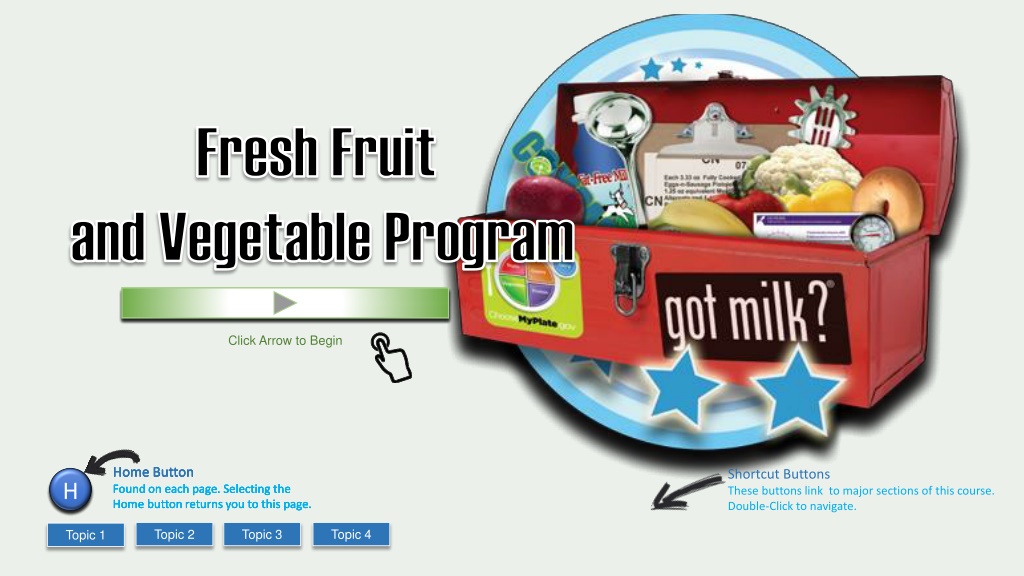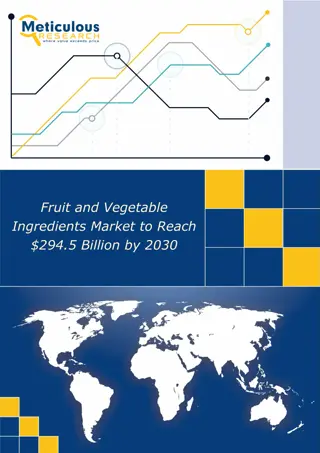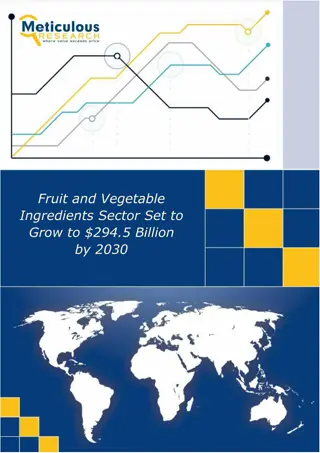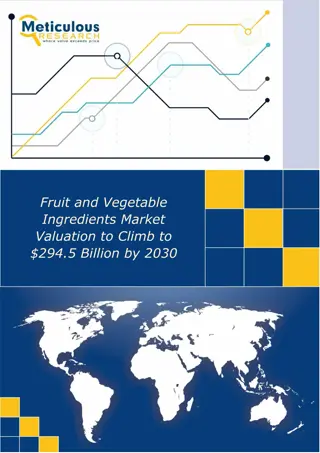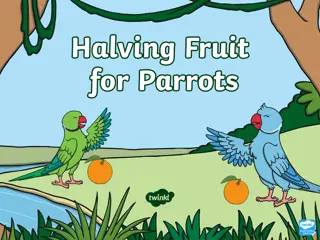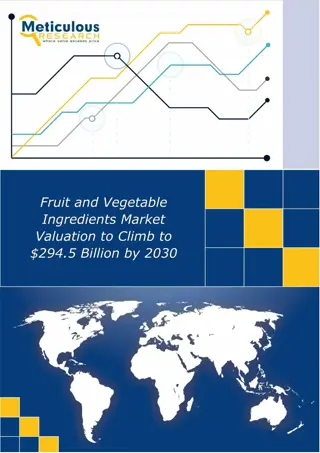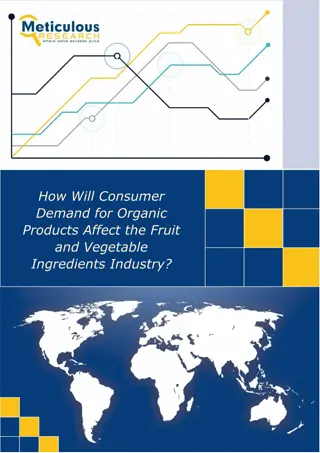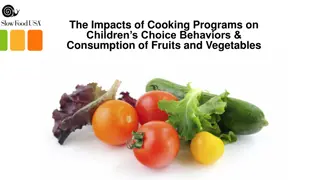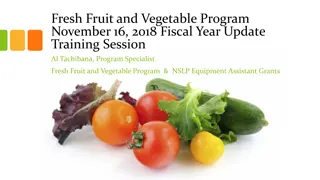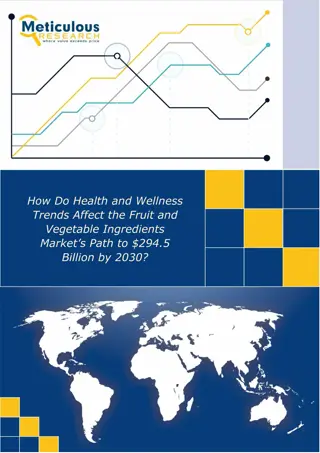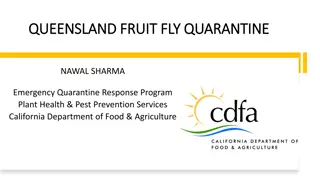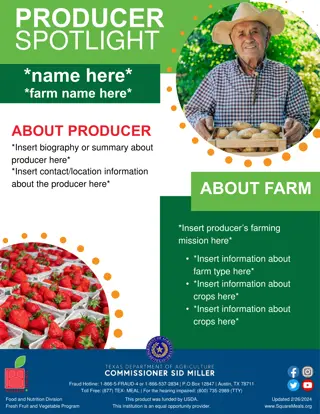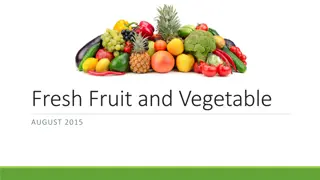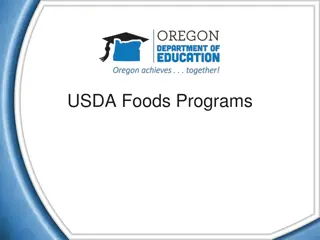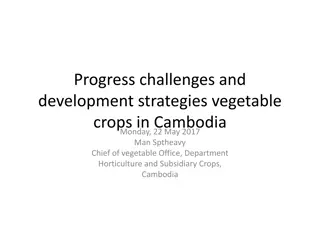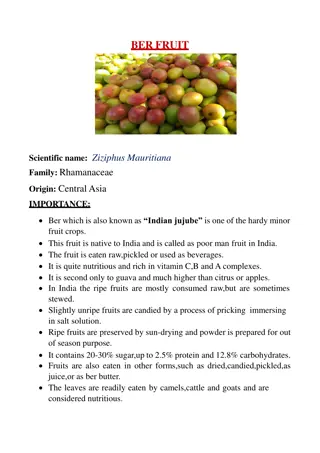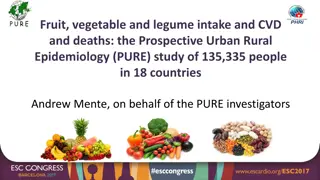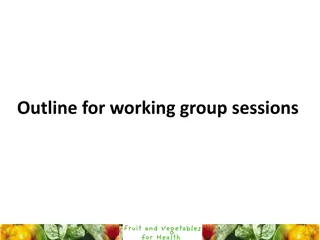Pennsylvania's Fresh Fruit & Vegetable Program Overview
Introduction to Pennsylvania's Fresh Fruit and Vegetable Program, outlining its background, goals, and selection criteria. The program, administered by the Pennsylvania Department of Education, aims to provide schools with grants for promoting fresh produce consumption among students. Explore the key requirements and success factors of the program to understand its impact on school nutrition.
Download Presentation

Please find below an Image/Link to download the presentation.
The content on the website is provided AS IS for your information and personal use only. It may not be sold, licensed, or shared on other websites without obtaining consent from the author. Download presentation by click this link. If you encounter any issues during the download, it is possible that the publisher has removed the file from their server.
E N D
Presentation Transcript
Fresh Fruit and Vegetable Program Begin Course Begin Course Begin Course Begin Course Click Arrow to Begin Home Button Found on each page. Selecting the Home button returns you to this page. Home button returns you to this page. Home button returns you to this page. Home button returns you to this page. Home Button Found on each page. Selecting the Found on each page. Selecting the Found on each page. Selecting the Home Button Home Button Shortcut Buttons These buttons link to major sections of this course. Double-Click to navigate. H H H H Topic 2 Topic 3 Topic 4 Topic 1 Topic 2 Topic 3 Topic 4 Topic 1
Fresh Fruit and Vegetable Program N NAVIGATION AVIGATION School Nutrition Toolbox School Nutrition Toolbox School Nutrition Toolbox School Nutrition Toolbox Marketing School Meals Put Course Name Here Put Course Name Here Navigation is pretty basic. Back Button, Forward Button, and Home Button. Forward Button Back Button Found on each page. Selecting the Back button returns you to the previous page. Found on each page. Selecting the Forward button advances you to the next page. Home Button Found on each page. Selecting the H H H H H H Navagation link to return to table of contents for the presentation. H H H Navagation link to return to table of contents for the presentation. Home button returns you to the very beginning page. H H H
T TOPIC OPIC 1 | P 1 | PENNSYLVANIA ENNSYLVANIA' 'S S F FRESH RESH F FRUIT RUIT & V & VEGETABLE EGETABLE P PROGRAM ROGRAM Introduction This module is intended for use by Pennsylvania schools that have been awarded Fresh Fruit and Vegetable Program (FFVP) grants and is intended to provide an understanding of the requirements of the program for those schools. Administrators who are responsible for operating the FFVP in their school(s) must pass the post-test and ensure faculty and staff who are involved in the program understand the regulations. This module may also be of use to other schools that may be interested in applying for the program next year. Fresh Fruit and Vegetable Program School Nutrition Toolbox School Nutrition Toolbox School Nutrition Toolbox School Nutrition Toolbox Marketing School Meals Put Course Name Here Put Course Name Here The module sections include the following: 1. 2. 3. Fresh Fruit and Vegetable Program: Background, Goals, and Selection Criteria (Topic 2) Fresh Fruit and Vegetable Program Requirements (Topic 3) Keys to Success (Topic 4) H H H H H H Navagation link to return to table of contents for the presentation. H H H Navagation link to return to table of contents for the presentation. H H H
T TOPIC OPIC 2 | G 2 | GOALS OALSAND AND S SELECTION ELECTION C CRITERIA RITERIA Participants will: 1. 2. State the goals of the FFVP. List the selection criteria and relate them to their own situation. Fresh Fruit and Vegetable Program School Nutrition Toolbox School Nutrition Toolbox School Nutrition Toolbox School Nutrition Toolbox Marketing School Meals Background The Fresh Fruit and Vegetable Program (FFVP) is a federal program administered at the state level by the Pennsylvania Department of Education (PDE), similar to other school meal programs. The FFVP began as a pilot program in four states in 2002. The success of the pilot led to the expansion of the program in 2004 to four additional states, including Pennsylvania. The Food, Conservation, and Energy Act of 2008 (Farm Bill) permanently authorized the program nationwide. Each school year, Pennsylvania receives funding that enables thousands of the Commonwealth s students to participate in the program. Put Course Name Here Put Course Name Here Goals The purpose of the FFVP is to introduce and reinforce healthy eating habits through the offering of fresh produce to students in schools. The goals of the FFVP are to: 1. Expand the variety of fruits and vegetables children experience There are several hundred varieties of fruits and vegetables and it is the intent of the program to expose children to as many different types as possible. Fruits and vegetables of different colors offer different nutrients. Continually changing it up provides nutrient variety and holds students interest. 2. Increase children s fruit and vegetable consumption On average, only 14% of school children eat the recommended servings of fruit and only 17% eat the recommended servings of vegetables daily. The FFVP gives children more opportunities to meet these requirements and develop healthier eating habits. Continued on next slide. H H H H H H Navagation link to return to table of contents for the presentation. H H H Navagation link to return to table of contents for the presentation. H H H
T TOPIC OPIC 2 | G 2 | GOALS OALSAND AND S SELECTION ELECTION C CRITERIA RITERIA Goals (continued) 3. Make a difference in children s diets to impact their present and future health The FFVP is seen as an important catalyst for change in efforts to combat childhood obesity by helping children learn more healthful eating habits. Diets rich in fruits and vegetables may also reduce the risk of cancer and other chronic diseases. Fresh Fruit and Vegetable Program School Nutrition Toolbox School Nutrition Toolbox School Nutrition Toolbox School Nutrition Toolbox Marketing School Meals Put Course Name Here Put Course Name Here Selection Criteria The selection criteria for the FFVP include the following: 1. Applicants must be in good standing as a National School Lunch Program (NSLP) sponsor with satisfactory participation in the NSLP and other federal programs. 2. Schools must be elementary schools. In schools that combine elementary grades with secondary or high school, program administrators must separate the elementary students from the rest of the student population. Program regulations restrict participation in the FFVP to only students in grades 6 and below in public schools, and grades 8 and below in private schools. 3. Free and reduced lunch rates for individual schools (not the entire district) are considered in the selection process. Priority is given to schools with the highest rates. For schools participating in the Community Eligibility Provision (CEP), the individual building percentage will be used for ranking purposes. 4. Schools must demonstrate the ability to administer the FFVP (based on the FFVP application) in accordance with USDA FFVP guidelines. The ability to administer the program can also be determined by considering prior year participation in the FFVP. H H H H H H Navagation link to return to table of contents for the presentation. H H H Navagation link to return to table of contents for the presentation. H H H
T TOPIC OPIC 3 | R 3 | REQUIREMENTS EQUIREMENTS & C & CATEGORIES ATEGORIESOF OFTHE THE FFVP FFVP Participants will: 1. State the requirements for operating the FFVP, including minimum number of times the program must be offered per week, when the snacks may and may not be offered, who may and may not consume the snacks, and how leftovers should be handled. State the requirements for procuring fruits and vegetables. Classify items as reimbursable and non-reimbursable through FFVP funding. Describe ways to advertise the availability of the FFVP throughout the school building. State the requirement for providing nutrition education and identify sources and methods of providing nutrition education. State the grant timeframe and the deadlines for expending funds. Demonstrate the differences between operational and administrative expenses and state the requirements related to both. Describe the process for submitting claims for reimbursement. State how and when the FFVP is monitored and understand that a program sponsor may request a Technical Assistance visit. 10. Identify the person in the school/district who will receive correspondence from PDE about the FFVP by becoming the School Food Authority s FFVP contact person. This must be a school/district employee. It cannot be a Food Service Management Company employee, contractor, or consultant. Fresh Fruit and Vegetable Program School Nutrition Toolbox School Nutrition Toolbox School Nutrition Toolbox School Nutrition Toolbox 2. 3. 4. 5. Marketing School Meals Put Course Name Here Put Course Name Here 6. 7. 8. 9. Continued on next slide. H H H H H H Navagation link to return to table of contents for the presentation. H H H Navagation link to return to table of contents for the presentation. H H H
T TOPIC OPIC 3 | R 3 | REQUIREMENTS EQUIREMENTS & C & CATEGORIES ATEGORIESOF OFTHE THE FFVP FFVP The requirements of the FFVP fall into the following categories: Fresh Fruit and Vegetable Program 1. Program Operation School Nutrition Toolbox School Nutrition Toolbox School Nutrition Toolbox School Nutrition Toolbox 2. Procurement Marketing School Meals Put Course Name Here Put Course Name Here 3. Non-Reimbursable Items and Reimbursable Extras 4. Advertising 5. Nutrition Education 6. Fiscal Requirements 7. Claims for Reimbursement 8. Monitoring 9. Communication H H H H H H Navagation link to return to table of contents for the presentation. H H H Navagation link to return to table of contents for the presentation. H H H
T TOPIC OPIC 3 | A | P 3 | A | PROGRAM ROGRAM O OPERATIONS PERATIONS FFVP produce cannot be served in conjunction with the School Breakfast Program, National School Lunch Program, or Afterschool Snack Program. Funds may not be used to purchase or replace breakfast or lunch foods or to supplement breakfast, lunch, or snack. FFVP produce may not be served in the cafeteria during breakfast or lunch. FFVP produce must be served at least three times per week starting at the beginning of the school year and throughout the entire remainder of the school year, but not during the summer months, with the exception of year-round schools (NOT summer school ). Vegetables and fruits should be served equally. The produce should be offered in multiple areas throughout the school to increase exposure. Most schools use classrooms or a combination of classrooms and hallway kiosks to deliver fresh fruits and vegetables to children. See pages 12-13 of Fresh Fruit and Vegetable Program: A Handbook for Schools for additional ideas about places to distribute the fruits and vegetables. Fresh Fruit and Vegetable Program School Nutrition Toolbox School Nutrition Toolbox School Nutrition Toolbox School Nutrition Toolbox Marketing School Meals Put Course Name Here Put Course Name Here Click here for Fresh Fruit and Vegetable Program: A Handbook for Schools Guidelines should be developed to remind children of good manners when they receive and eat their fruit and vegetable snacks and to dispose of their trash appropriately. If some children decide not to try a certain fruit or vegetable snack, you may still encourage them to accept it to touch or smell the fruit or vegetable. Encourage respectful language such as no, thank you rather than negative comments which may affect the opinion of other students. Continued on next slide. H H H H H H Navagation link to return to table of contents for the presentation. H H H Navagation link to return to table of contents for the presentation. H H H
T TOPIC OPIC 3 | A | P 3 | A | PROGRAM ROGRAM O OPERATIONS PERATIONS FFVP produce must be served during school hours. It may not be taken home, offered before or after school, on weekends, or at any after-school event. FFVP produce cannotbe made available to the general teacher population or other adults. Samples may not be provided in the main office or faculty lounge. Teachers and teacher aides responsible for administering the program in their individual classrooms may participate for the purpose of encouraging their students to try the fruit or vegetable snack by modeling good eating habits and willingness to try new things. FFVP produce must be offered equally to all eligible enrolled elementary students, meaning that all students receive the fruits and vegetables the same number of times per week. The fruit and vegetable snacks may be offered to different students on different days and the items offered may differ. However, all students must have access to the snack equally. FFVP produce may not be used as a reward or withheld from a student for disciplinary reasons. If a child s disability prevents him/her from consuming fresh fruits and vegetables as prepared, the school s food service staff must provide accommodations as they would for other school meals. FFVP snacks may be sent on field trips that occur during school hours, but they may not be sent to athletic or other events that occur after school hours. If FFVP snacks are provided for field trips, parents and chaperones are not permitted to participate in consumption of the snacks. As with other school meal programs, plan to reduce waste. Plan to use the fruits and vegetables purchased with FFVP funds as part of the FFVP. In cases when FFVP produce is leftover, the first priority should be to use it in the FFVP, either by offering second helpings to students who would eat more of the item, or using it on another day. Another option is to use leftovers in school meal programs, or donate them to a charity. Check with your local health department for clarification on how leftovers are defined and for guidelines for handling them. Fresh Fruit and Vegetable Program School Nutrition Toolbox School Nutrition Toolbox School Nutrition Toolbox School Nutrition Toolbox Marketing School Meals Put Course Name Here Put Course Name Here Continued on next slide. H H H H H H Navagation link to return to table of contents for the presentation. H H H Navagation link to return to table of contents for the presentation. H H H
T TOPIC OPIC 3 | A | P 3 | A | PROGRAM ROGRAM O OPERATIONS PERATIONS Fresh produce must be handled safely to reduce the risks of foodborne illness. See Best Practices for Handling Fresh Produce in Schools through the link below. Food safety information can also be found on PEARS Download Forms > Fresh Fruit & Vegetable Program section. Fresh Fruit and Vegetable Program Click here for Best Practices for Handling Fresh Produce in Schools School Nutrition Toolbox School Nutrition Toolbox School Nutrition Toolbox School Nutrition Toolbox Marketing School Meals Put Course Name Here Put Course Name Here Any revisions to plans for operating the FFVP must be approved by the Pennsylvania Department of Education before they are implemented. H H H H H H Navagation link to return to table of contents for the presentation. H H H Navagation link to return to table of contents for the presentation. H H H
T TOPIC OPIC 3 | B | P 3 | B | PROCUREMENT ROCUREMENT FFVP schools must follow proper procurement procedures. Please see page 17 of USDA s Fresh Fruit and Vegetable Program: A Handbook for Schools at the link below for information about purchasing fruits and vegetables. Fresh Fruit and Vegetable Program Click here Fresh Fruit and Vegetable Program: A Handbook for Schools." School Nutrition Toolbox School Nutrition Toolbox School Nutrition Toolbox School Nutrition Toolbox Marketing School Meals Put Course Name Here Put Course Name Here Schools must follow federal, state, and local procurement guidelines for FFVP purchases. Schools should seek competitive pricing throughout the grant year. Produce items that are not generally available as a domestic product, such as bananas, may be purchased even though they are not domestic. Schools are not required to apply a geographic preference when procuring produce, but they may choose to do so. For more information about geographic preference, see the link below. Click here for more information about geographic preference. Schools may choose to support farm to school programs by purchasing fresh fruits and vegetables from local farmers. For more information about farm to school, see the following websites: Click here for USDA Farm to School (Office of Community Food Systems). Click here for National Farm to School Network. Click here for Project PA (click on Farm to School tab). H H H H H H Navagation link to return to table of contents for the presentation. H H H Navagation link to return to table of contents for the presentation. H H H
T TOPIC OPIC 3 | C | N 3 | C | NON ON- -R REIMBURSABLE R REIMBURSABLE EIMBURSABLE I ITEMS EIMBURSABLE E EXTRAS TEMSAND AND XTRAS It is important for schools to understand the items that are and are not allowed to be purchased using FFVP funds so items are not purchased for which reimbursement is not allowed. Keep in mind that this list is not all-inclusive, and the Pennsylvania Department of Education reserves the right to deny a claimed item, within reason, to ensure compliance with USDA standards and regulations. If you have questions about an item, please contact PDE (ra- ffvp@pa.gov) BEFORE purchasing it. Fresh Fruit and Vegetable Program School Nutrition Toolbox School Nutrition Toolbox School Nutrition Toolbox School Nutrition Toolbox Marketing School Meals Put Course Name Here Put Course Name Here Click here to contact PDE if you have questions about an item. The FFVP does NOT allow: Dried, frozen, vacuum-packed, or canned produce Dessert-like items (e.g., smoothies) Fruit juice Added ingredients or injected flavorings (e.g., Crazy Apples, Grapples, fruit leather.) Dips for fruit (dips for fruit are not allowed even if they are low-fat or yogurt-based and cannot be served with even if the dip is purchased with non-FFVP funds.) Processed or canned vegetables (e.g., pickles, olives) Vegetables with added salt Other items not considered a fruit or vegetable for the purposes of this program: edible flowers, herbs, pumpkin seeds. Payment for nutrition education materials H H H H H H Navagation link to return to table of contents for the presentation. H H H Navagation link to return to table of contents for the presentation. H H H
T TOPIC OPIC 3 | C | N 3 | C | NON ON- -R REIMBURSABLE R REIMBURSABLE EIMBURSABLE I ITEMS EIMBURSABLE E EXTRAS TEMSAND AND XTRAS Reimbursable Extras Dips for vegetables If you choose to serve dip with vegetables, make sure to only offer low fat or non fat dips. The amount used should be what is commonly noted as a serving size for condiments, as shown on Nutrition Facts Labels: 1 to 2 tablespoons. If students are currently sampling vegetables without the use of dip, do not feel compelled to start offering it. PDE will not approve claims for unreasonable amounts of dip. Peanut butter (not commodity) for vegetables. Does not have to be low-fat. Fresh Fruit and Vegetable Program School Nutrition Toolbox School Nutrition Toolbox School Nutrition Toolbox School Nutrition Toolbox Marketing School Meals Put Course Name Here Put Course Name Here Prepared Vegetables Vegetables that are purchased fresh may be cooked / prepared up to one time per week and must include a nutrition education lesson related to the prepared item. H H H H H H Navagation link to return to table of contents for the presentation. H H H Navagation link to return to table of contents for the presentation. H H H
T TOPIC OPIC 3 | D | A 3 | D | ADVERTISING DVERTISING FFVP schools must actively advertise the availability of the program. Advertising ideas include: Include information on menus which are sent home to parents. Publicize the program during morning announcements. Advertise in newsletters. Display posters throughout the school. Consider allowing students to design and create the posters. Fresh Fruit and Vegetable Program School Nutrition Toolbox School Nutrition Toolbox School Nutrition Toolbox School Nutrition Toolbox Marketing School Meals Put Course Name Here Put Course Name Here H H H H H H Navagation link to return to table of contents for the presentation. H H H Navagation link to return to table of contents for the presentation. H H H
T TOPIC OPIC 3 | E | N 3 | E | NUTRITION UTRITION E EDUCATION DUCATION One of the goals of the FFVP is to make a noticeable difference in children s diets to impact their present and future health. Nutrition education is a key part of meeting this goal. Schools that offer the FFVP are required to provide some form of nutrition education to students. This nutrition education may take a variety of formats including the following: Fresh Fruit and Vegetable Program School Nutrition Toolbox School Nutrition Toolbox School Nutrition Toolbox School Nutrition Toolbox Food demonstrations Reading books about fruits and vegetables Sharing nutrition information during morning announcements Talking to students about fruits and vegetables as they are having the snack. Encourage teachers to be excited about the produce when presenting to the students. Positivity is contagious! Monthly newsletters and calendars Nutrition-themed assemblies Nutrition-themed contests Marketing School Meals Put Course Name Here Put Course Name Here Nutrition education materials are NOT reimbursable. For this reason, PDE encourages schools to utilize free resources. Schools may want to consider reaching out to community partners as sources of free or low-cost nutrition education and volunteers. Potential partners include local chefs, dietitians, parents, farmers, Penn State Extension (https://extension.psu.edu/), and others. Lists of potential resource partners and nutrition education resources are available on PEARS Download Forms > Fresh Fruit & Vegetable Program section: Examples of Non-Federal Resource Partners and FFVP Nutrition Education Resources. According to surveyed schools, activities that are hands-on and involve touching, smelling, and tasting the fruits and vegetables leave a lasting impression on the students. Educational activities can teach about the origins of fruits and vegetables including how they are grown and harvested and how they make their way from the field to the plate. Continued on next slide. H H H H H H Navagation link to return to table of contents for the presentation. H H H Navagation link to return to table of contents for the presentation. H H H
T TOPIC OPIC 3 | E | N 3 | E | NUTRITION UTRITION E EDUCATION DUCATION PDE also suggests offering interdisciplinary nutrition education, meaning integrating nutrition into various subject areas such as math, reading, vocabulary, civics, and science classes. Fresh Fruit and Vegetable Program Click here for Penn State Extension. School Nutrition Toolbox School Nutrition Toolbox School Nutrition Toolbox School Nutrition Toolbox Marketing School Meals Put Course Name Here Put Course Name Here FFVP schools in Pennsylvania have provided nutrition education to their students in creative ways: Mechanicsburg School District, students helped with televised morning announcements to provide education about the fruit or vegetable of the day. They also used a color of the month theme to select the featured fruits and vegetables provided for snacks. Inquiry Charter School used peer to peer nutrition education, giving students experience in conducting presentations. One class received the fruit or vegetable, researched nutrition information about it, and presented their findings to the class next door. Each class presented to another class. Norristown School District shared ways that different grades have expanded classroom learning alongside the FFVP. Kindergarteners practiced counting fruits and vegetables. First graders used a thumbs up, thumbs down survey to record who liked the fruit or vegetable, and then tallied results. Second graders focused on unusual fruits and vegetables and learned about their differences. Third graders made observations and used vivid language in writing about fruits and vegetables. Fourth graders researched about favorite healthy foods, and each student produced a digital presentation. Continued on next slide. H H H H H H Navagation link to return to table of contents for the presentation. H H H Navagation link to return to table of contents for the presentation. H H H
T TOPIC OPIC 3 | E | N 3 | E | NUTRITION UTRITION E EDUCATION DUCATION FFVP schools in Pennsylvania have provided nutrition education to their students in creative ways: (continued) Fresh Fruit and Vegetable Program York City School District students ranked fruits and vegetables from most to least favorite, incorporated fruits and vegetables into learning about predictions, and learned about crop rotation in the context of the fruits and vegetables they were sampling. They discussed how the vegetables can be prepared in different ways, relating this to family cultural foods. Fresh Fruit and Vegetable Program snack time provided opportunities to highlight respect when waiting to have an opportunity to taste the fruit or vegetable. School Nutrition Toolbox School Nutrition Toolbox School Nutrition Toolbox School Nutrition Toolbox Marketing School Meals Put Course Name Here Put Course Name Here Click here for Fresh Fruit and Vegetable Program: A Handbook for Schools . Please see pages 20-21 for additional nutrition education ideas.. H H H H H H Navagation link to return to table of contents for the presentation. H H H Navagation link to return to table of contents for the presentation. H H H
T TOPIC OPIC 3 | F | F 3 | F | FISCAL ISCAL R REQUIREMENTS EQUIREMENTS The FFVP grant begins on July 1 of the current year and ends on June 30 of the following calendar year. The total grant amount is separated into two allotments of money. The first allotment must be spent by September 30 of the current year. The second allotment spending begins on October 1 and ends on the following June 30. Remaining unspent funds in the first allotment will not be carried over into the second allotment. Funds that are not obligated by September 30 will be reclaimed by USDA. This amount needs to be enough to provide quality fruits and vegetables to your students throughout the school year as schools will not receive additional funding. Reimbursable expenditures are operational or administrative costs, as specified below: Fresh Fruit and Vegetable Program School Nutrition Toolbox School Nutrition Toolbox School Nutrition Toolbox School Nutrition Toolbox Marketing School Meals Put Course Name Here Put Course Name Here Operational Expenses include: Fresh fruits and vegetables To save on labor expenses, USDA encourages schools to purchase value-added items such as pre- packaged or trays of fruit and vegetables. Delivery charges are allowable. Other operational costs (limited to no more than 15% of monthly claim) Labor associated with preparing and serving the fruits and vegetables (does not include labor for administering the program). Claiming labor hours is not mandatory. Many schools do not claim labor hours and therefore have more funds available to purchase fruits and vegetables. Small supplies (e.g., spoons, bowls, baggies, plastic gloves, etc.) Condiments (e.g., low-fat or non-fat dips or peanut butter for vegetables.) o Whether the dip is low-fat or non-fat must be stated on the FFVP claim. Peanut butter may be served in limited amounts. Light/Lite dressings/dips are not permitted. H H H H H H Navagation link to return to table of contents for the presentation. H H H Navagation link to return to table of contents for the presentation. H H H
T TOPIC OPIC 3 | F | F 3 | F | FISCAL ISCAL R REQUIREMENTS EQUIREMENTS Administrative Expenses: Total administrative expenditures (labor and / or equipment) cannot exceed 10% of the total funding amount within the grant year. The 10% allowance for administrative costs is within the total grant funds. If not used for administrative costs, more money remains available for fruit and vegetable purchases. Labor cost for administering the program Administrative labor includes time spent completing paperwork, taking inventory, ordering fruits, vegetables, and supplies, and entering claims in PEARS. Claiming labor hours is permitted, but not mandatory. Large equipment (e.g. refrigerators, carts) Large equipment purchases must be pre-approved by PDE using the Equipment Request Form that is part of the FFVP application. If a sponsor wants to make a request to purchase large equipment after already having submitted the application without completing the Equipment Request Form section, contact PDE at RA-FFVP@pa.gov. Equipment purchase requests will be reviewed and compared with the available administrative allowance and prior year purchases, if applicable, and PDE will contact the sponsor with a response. Sponsors must document on the FFVP claim comments section that the equipment purchase was pre-approved by PDE. Large equipment must be prorated if it will not be used exclusively for the FFVP. The cost of large equipment must be reasonable. The equipment purchase must be pre-approved by PDE. Schools will not be reimbursed more than 10 percent of the total grant amount for administrative expenses (pre-approved equipment purchases and administrative labor.) Schools should consider leasing equipment if it is too expensive to purchase. Fresh Fruit and Vegetable Program School Nutrition Toolbox School Nutrition Toolbox School Nutrition Toolbox School Nutrition Toolbox Marketing School Meals Put Course Name Here Put Course Name Here H H H H H H Navagation link to return to table of contents for the presentation. H H H Navagation link to return to table of contents for the presentation. H H H
T TOPIC OPIC 3 | G | M 3 | G | MONTHLY ONTHLY C CLAIMS LAIMSFOR FOR R REIMBURSEMENT EIMBURSEMENT Claims must be submitted for each month of operation. Claims for reimbursement must be submitted through PEARS and list each item for reimbursement. Only authorized school / district employees can be granted access to PEARS. The CN PEARS User Authorization Form can be found on PEARS Download Forms > Application Information for New Sponsors section. Non-produce operational charges for each month claimed cannot exceed 15% of the monthly claiming total for the respective school building. In the Sponsor Comments of each month s claim, document nutrition education activities carried out at the school, along with challenges and/or successes with the FFVP that month. A sponsor should enter the claims for all of its FFVP-participating schools. After all sites claims are entered, the Submit for Payment button should be clicked. The Claim Due Date and Payment Schedule can be found on PEARS Download Forms > Claims for Reimbursement section. Due dates for FFVP claims are the same as for the National School Lunch Program. Claims must be received within 60 days of the last day of the month for which the claim is being made. Revisions/corrections are due within the same time period of 60 days after the last day of the claiming month. If you need to revise your claim for any reason, please remember to re-submit your claim. The status of a submitted claim will display as Pending Approval. Accepted status will appear after PDE review and approval and will be paid on the next processing date. Processed indicates that the claim has been approved, processed, and will be (or has been) paid. Fresh Fruit and Vegetable Program School Nutrition Toolbox School Nutrition Toolbox School Nutrition Toolbox School Nutrition Toolbox Marketing School Meals Put Course Name Here Put Course Name Here Continued on next slide. H H H H H H Navagation link to return to table of contents for the presentation. H H H Navagation link to return to table of contents for the presentation. H H H
T TOPIC OPIC 3 | G | M 3 | G | MONTHLY ONTHLY C CLAIMS LAIMSFOR FOR R REIMBURSEMENT EIMBURSEMENT If you have a claim in any status other than Pending Approval, Accepted, or Processed, it is likely that there is something that you need to do with the claim. For example, Pending Validation or Pending means that the claim has not been submitted and will not appear on PDE s list to review. This may result in a late or unpaid claim. Be sure to complete such claims and submit them for payment before the specified deadline. If you have a question about the status of your claim, please promptly contact the FFVP coordinator (contact information at the end of this training module). PDE reserves the right to review each claim in depth. Schools may be contacted for clarification if needed. It is the school s responsibility to keep ALL receipts and invoices for three years plus the current school year. Schools may be asked to share receipts or invoices with PDE or USDA at any time. Fresh Fruit and Vegetable Program School Nutrition Toolbox School Nutrition Toolbox School Nutrition Toolbox School Nutrition Toolbox Marketing School Meals Put Course Name Here Put Course Name Here Expense Categories The expense categories include fruit and vegetables, operational costs (non-produce), and administrative costs (administrative labor and large equipment). When listing the fruit and vegetables costs, schools must enter the following: Product Description (e.g. apples, oranges, broccoli) Size/Weight of Shipping Unit (e.g. pint, pound, case) Number of Units (e.g. 2 (cases)) Cost per unit (e.g. $42.00) The total cost of each item will be calculated by PEARS. However, this number can be changed if necessary. Please double-check numbers to ensure claims are correct. H H H H H H Navagation link to return to table of contents for the presentation. H H H Navagation link to return to table of contents for the presentation. H H H
T TOPIC OPIC 3 | H | M 3 | H | MONITORING ONITORING Schools that are operating the FFVP and have an administrative review (AR) scheduled during that school year will have an on-site FFVP review. The off-site portion will require FFVP sponsors to submit invoices and timesheets to support the target month s claim, as well as sample nutrition education materials, which will be reviewed by staff at PDE. The on-site portion will occur at the same time as the AR by the field advisor. During the site visit, PDE will expect to observe the program operation, including how the food service staff organizes the produce, the manner in which the fruits and vegetables are distributed, and the children receiving the fruits and vegetables. Schools that do not have an AR scheduled may still have an on-site FFVP review. Schools may request technical assistance if they are unsure about the FFVP s operating logistics or are anticipating or experiencing organizational issues. All FFVP documents must be retained for a period of three years plus the current school year. Fresh Fruit and Vegetable Program School Nutrition Toolbox School Nutrition Toolbox School Nutrition Toolbox School Nutrition Toolbox Marketing School Meals Put Course Name Here Put Course Name Here H H H H H H Navagation link to return to table of contents for the presentation. H H H Navagation link to return to table of contents for the presentation. H H H
T TOPIC OPIC 3 | I | C 3 | I | COMMUNICATION OMMUNICATION Official correspondence from PDE will be addressed to the FFVP contact person listed on the PEARS Application Packet, Fresh Fruit and Vegetable Program Application, and/or the Primary Contact in PEARS for the sponsor. It is the responsibility of both these contact individuals to pass on FFVP information to all other school staff involved with the FFVP. The FFVP contact person must be a school district employee with authorized access to PEARS. Fresh Fruit and Vegetable Program School Nutrition Toolbox School Nutrition Toolbox School Nutrition Toolbox School Nutrition Toolbox Marketing School Meals Put Course Name Here Put Course Name Here H H H H H H Navagation link to return to table of contents for the presentation. H H H Navagation link to return to table of contents for the presentation. H H H
T TOPIC OPIC 4: K 4: KEYS EYSTO TO S SUCCESS UCCESS Participants will: 1. List keys to implementing a successful FFVP. Fresh Fruit and Vegetable Program Keys to Success Some key factors leading to a successful FFVP include the following: Foster cooperation and teamwork. Engage principals, teachers, food service staff, and students from the beginning of the program. Solicit support from community partnerships. Use other schools as a resource. Schools implement the FFVP and provide nutrition education in a variety of ways. Learn from what other schools are doing and find what works best in your school. Use PDE as a resource. PDE staff is available to assist with program questions and issues. Email ra-ffvp@pa.gov for assistance. Budget appropriately. Use the funding to the maximum extent possible. Closely monitor spending so you do not run out of funds before the end of the school year while also using all of the allocated funding. Find fun ways to introduce new and different fruits and vegetables. Some schools have been successful in gaining acceptance for new, unfamiliar fruit and vegetables by offering them with a more familiar fruit or vegetable. Make activities hands-on and interactive. Make learning about and trying new fruits and vegetables a fun experience for everyone involved. School Nutrition Toolbox School Nutrition Toolbox School Nutrition Toolbox School Nutrition Toolbox Marketing School Meals Put Course Name Here Put Course Name Here Continued on next slide. H H H H H H Navagation link to return to table of contents for the presentation. H H H Navagation link to return to table of contents for the presentation. H H H
T TOPIC OPIC 4: K 4: KEYS EYSTO TO S SUCCESS UCCESS Keys to Success (continued) Fresh Fruit and Vegetable Program Provide appropriate portions of visually appealing produce in convenient locations. Make sure the produce is at the appropriate ripeness and quality. Offer the produce at convenient times in convenient locations in containers such as baggies, souffl cups, or on small plates. Provide napkins or wipes (both are reimbursable) to the students for use on hands and/or desks. Encourage teachers to model healthy behaviors. Have the teachers participate with the students, try the fresh produce, and encourage students to do the same. School Nutrition Toolbox School Nutrition Toolbox School Nutrition Toolbox School Nutrition Toolbox Marketing School Meals Put Course Name Here Put Course Name Here Click here for to email ra-ffvp@pa.gov at PDE for assistance. H H H H H H Navagation link to return to table of contents for the presentation. H H H Navagation link to return to table of contents for the presentation. H H H
Fresh Fruit and Vegetable Program School Nutrition Toolbox H H
